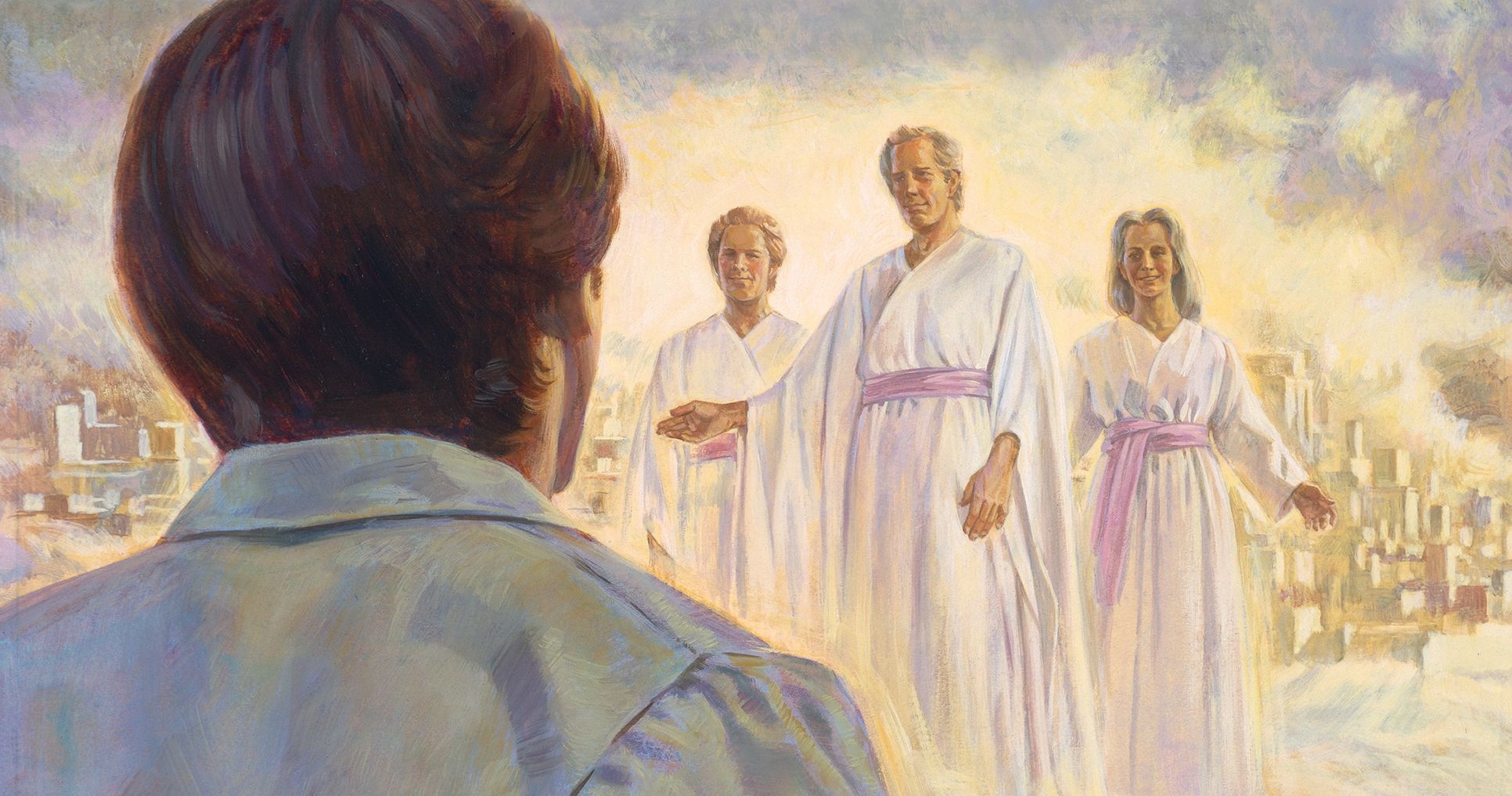You are here
Book of Mormon Central is in the process of migrating to our new Scripture Central website.
We ask for your patience during this transition. Over the coming weeks, all pages of bookofmormoncentral.org will be redirected to their corresponding page on scripturecentral.org, resulting in minimal disruption.

D&C 137–138
New from BMC
Watch videos from Gospel scholars and teachers to learn more about these sections of the Doctrine and Covenants. Book of Mormon Central produces weekly videos from Tyler Griffin, Taylor Halverson, John Hilton III, Anthony Sweat, Casey Griffiths, Stephanie Dibb Sorensen and Marianna Richardson. Read commentaries and other resources from KnoWhys, Steven C. Harper, Casey Griffiths, and Susan Easton Black.
Videos
Doctrine and Covenants 137
Doctrine and Covenants 138
Daily Reading Plan
Structure your personal scripture study by following a 15-minute, day-by-day plan. Each day's assignment includes the required scripture passages from the Come, Follow Me curriculum, as well as suggestions for additional resources to bring context and understanding to your study. For the best experience, use our Reading Plan in the free ScripturePlus app! You can track your progress and have access to the best resources.
Monday
- Commentary: Section 137 Context, Steven C. Harper
- Scripture: D&C 137:1–10
- Commentary: Casey Paul Griffiths, Doctrine and Covenants Minute, Doctrine and Covenants 137:1–6.
- Commentary: Casey Paul Griffiths, Doctrine and Covenants Minute, Doctrine and Covenants 137:7–9.
- Commentary: Casey Paul Griffiths, Doctrine and Covenants Minute, Doctrine and Covenants 137:10.
Tuesday
- Commentary: Section 138 Context, Steven C. Harper
- Scripture: D&C 138:1–10
- Commentary: Casey Paul Griffiths, Doctrine and Covenants Minute, Doctrine and Covenants 138:1–10.
-
Quote: The snare of false inadequacy. A faithful young person feels unable to meet the expectations of others. At home and school, she is rarely praised and often criticized. The popular media tells her she is not beautiful enough or smart enough. Every day this righteous sister questions whether she is an individual worthy of Heavenly Father’s love, the Savior’s atoning sacrifice, or the Spirit’s constant guidance.
The snare of exaggerated imperfection. An outstanding missionary feels incapable of meeting the expectations of God. In his mind, this worthy elder imagines a stern Heavenly Father bound to irrevocable justice, a Savior capable of cleansing others’ transgressions but not this elder’s own, and a Holy Ghost unwilling to accompany an imperfect person.
The snare of needless guilt. A middle-aged woman is a devoted mother, a loving friend, a faithful Church servant, and a frequent temple patron. But in her heart, this sister cannot forgive herself of sins committed years ago that she has repented of and fully resolved with priesthood leaders. She doubts that her life will ever be acceptable to the Lord and has lost hope of eternal life in Heavenly Father’s presence.
If you have any thoughts and feelings similar to these good Saints, I invite you to become as a little child and feel again “the great and wonderful love made manifest by the Father and the Son in the coming of the Redeemer into the world” (D&C 138:3). Childlike faith in the perfect love of Heavenly Father and Jesus Christ will “divide asunder” (Helaman 3:29). Satan’s snares of inadequacy, imperfection, and guilt.
Anthony D. Perkins, “The Great and Wonderful Love,” October 2006 General Conference.
Wednesday
- Scripture: D&C 138:11–19
- Commentary: Casey Paul Griffiths, Doctrine and Covenants Minute, Doctrine and Covenants 138:11–15.
- Commentary: Casey Paul Griffiths, Doctrine and Covenants Minute, Doctrine and Covenants 138:16–24.
-
Quote: For me, President Joseph F. Smith set an example of how pondering can invite light from God. It is recorded in the 138th section of the Doctrine and Covenants. He had been reading and studying many scriptures, trying to understand how the effects of the Savior’s Atonement would reach those who had died never having heard His message. Here is his account of how revelation came: “As I pondered over these things which are written, the eyes of my understanding were opened, and the Spirit of the Lord rested upon me, and I saw the hosts of the dead, both small and great” (D&C 138:11).
Repentance, prayer, and pondering over the scriptures are essential parts of our qualifying for the gifts of the Spirit in our priesthood service. Further magnification of our power to serve will come as we respond with faith to go forward in our callings with the Holy Ghost to help us.
Henry B. Eyring, “Serve with the Spirit,” October 2010 General Conference. -
Quote: For reasons usually unknown, some people are born with physical limitations. Specific parts of the body may be abnormal. Regulatory systems may be out of balance. And all of our bodies are subject to disease and death. Nevertheless, the gift of a physical body is priceless. Without it, we cannot attain a fulness of joy (D&C 138:17).A perfect body is not required to achieve a divine destiny. In fact, some of the sweetest spirits are housed in frail frames. Great spiritual strength is often developed by those with physical challenges precisely because they are challenged. Such individuals are entitled to all the blessings that God has in store for His faithful and obedient children (Abr. 3:25–26).
Russell M. Nelson, “We Are Children of God,” October 1998 General Conference.
Thursday
- Scripture: D&C 138:20–31
- Commentary: Casey Paul Griffiths, Doctrine and Covenants Minute, Doctrine and Covenants 138:25–31.
-
Quote: Modern revelation teaches us that our progress need not conclude with the end of mortality. Little has been revealed about this important assurance. We are told that this life is the time to prepare to meet God and that we should not procrastinate our repentance (Alma 34:32–33). Still, we are taught that in the spirit world the gospel is preached even to “the wicked and the disobedient who had rejected the truth” (D&C 138:29). and that those taught there are capable of repentance in advance of the Final Judgment (D&C 138:31–34, 57–59).
Dallin H. Oaks, “The Great Plan,” April 2020 General Conference. - Bio: Joseph F. Smith, Susan Easton Black.
Friday
- Scripture: D&C 138:32–40
- Commentary: Casey Paul Griffiths, Doctrine and Covenants Minute, Doctrine and Covenants 138:32–37.
-
Quote: President Joseph F. Smith recorded his vision of the hosts of the dead, in which he saw the great and mighty, and among them Adam and Eve. He describes the setting in which he sees Eve in this language: “And our glorious Mother Eve, with many of her faithful daughters who had lived through the ages and worshiped the true and living God” (D&C 138:39). Indeed, Mother Eve left a lasting legacy that comes down through the ages to bless the lives of all men and women.
As daughters of God, you cannot imagine the divine potential within each of you. Surely the secret citadel of women’s inner strength is spirituality. In this you equal and even surpass men, as you do in faith, morality, and commitment when truly converted to the gospel. You have “more trust in the Lord [and] more hope in his word.” This inner spiritual sense seems to give you a certain resilience to cope with sorrow, trouble, and uncertainty.
You cannot imagine the gifts and talents each of you has. All women have appealing features. I do not refer to model-type appeal, but rather that which comes from your personality, your attitude, and your expressions. I urge you to enhance the natural, God-given, feminine gifts with which you have been so richly blessed. None of you should be so content that you cease to care about how you look or act. In his day, President Brigham Young encouraged women to get an education. This is still good counsel, but I hasten to add: in all your getting, do not lose your sweet femininity.
James E. Faust, “What It Means to Be a Daughter of God,” October 1999 General Conference. - Video:
Saturday
- Scripture: D&C 138:41–52
- Commentary: Casey Paul Griffiths, Doctrine and Covenants Minute, Doctrine and Covenants 138:38–52.
-
Quote: God has the power to make our way easier. He fed manna to the children of Israel in their wandering to the promised land. The Lord in His mortal ministry healed the sick, raised the dead, and calmed the sea. After His Resurrection, He opened “the prison to them that were bound” (D&C 138:42).
Yet the Prophet Joseph Smith, one of the greatest of His prophets, suffered in prison and was taught the lesson we all profit from and need in our recurring tests of faith: “And if thou shouldst be cast into the pit, or into the hands of murderers, and the sentence of death passed upon thee; if thou be cast into the deep; if the billowing surge conspire against thee; if fierce winds become thine enemy; if the heavens gather blackness, and all the elements combine to hedge up the way; and above all, if the very jaws of hell shall gape open the mouth wide after thee, know thou, my son, that all these things shall give thee experience, and shall be for thy good” (D&C 122:7).
You might reasonably wonder why a loving and all-powerful God allows our mortal test to be so hard. It is because He knows that we must grow in spiritual cleanliness and stature to be able to live in His presence in families forever. To make that possible, Heavenly Father gave us a Savior and the power to choose for ourselves by faith to keep His commandments and to repent and so come unto Him.
Henry B. Eyring, “Tested, Proved, and Polished,” October 2020 General Conference. -
Quote: Many of you are descended from pioneers in this Church. They struggled so hard; they paid such a terrible price for their faith. Be true to them and true always to the Church they loved so much. I wish that each of you would remember that tonight you heard me say that this Church is true. Other churches also do much good, but this is the “true and living church” of the Lord Jesus Christ, whose name it bears (D&C 1:30). Be true to it. Cling to it. If you will do so it will become as an anchor in the midst of a stormy sea. It will be a light to your lives and a foundation upon which to build them. I give you my solemn testimony that this Church will never be led astray. It is in the hands of God, and should any of its leaders ever attempt to lead it astray, His is the power to remove them. He has said that He has restored His work for the last time, “never again to be destroyed nor given to other people” (D&C 138:44).
Gordon B. Hinckley , “Stand True and Faithful,” April 1996 General Conference. -
Quote: Our bodies are our temples. We are not less but more like Heavenly Father because we are embodied. I testify that we are His children, made in His image, with the potential to become like Him. Let us treat this divine gift of the body with great care. Someday, if we are worthy, we shall receive a perfected, glorious body—pure and clean like my new little granddaughter, only inseparably bound to the spirit. And we shall shout for joy (Job 38:7) to receive this gift again for which we have longed (D&C 138:50). May we respect the sanctity of the body during mortality so that the Lord may sanctify and exalt it for eternity.
Susan W. Tanner, “The Sanctity of the Body,” October 2005 General Conference.
Sunday
- Scripture: D&C 138:53–60
- Commentary: Casey Paul Griffiths, Doctrine and Covenants Minute, Doctrine and Covenants 138:53–56.
- Commentary: Casey Paul Griffiths, Doctrine and Covenants Minute, Doctrine and Covenants 138:57–60.
- Video: (casey)
Bibliography
Doctrine and Covenants 137
Steven C. Harper, “Section 137,” Doctrine and Covenants Contexts (Springville, UT: Book of Mormon Central, 2021), 369–372.
Susan Easton Black, “The Doctrine of Salvation for the Dead - Insight Into D&C 137,” Restoration Voices Volume 2: Insights and Stories of the Doctrine and Covenants (Springville, UT: Book of Mormon Central, 2021).
Susan Easton Black, “Alvin Smith,” Restoration Voices Volume 1: People of the Doctrine and Covenants (Springville, UT: Book of Mormon Central, 2021).
Lisa Olsen Tait and Brent Rogers, “A House for Our God,” Revelations in Context: The Stories Behind the Sections of the Doctrine and Covenants. Salt Lake City, UT: The Church of Jesus Christ of Latter-day Saints, 2016.
“The Spirit of God,” Saints, Volume 1: The Standard of Truth (Salt Lake City, UT: The Church of Jesus Christ of Latter-day Saints, 2018), 1:233–235.
“A Beautiful Place,” Saints, Volume 1: The Standard of Truth (Salt Lake City, UT: The Church of Jesus Christ of Latter-day Saints, 2018), 1:421–422.
“Kirtland Temple,” Church History Topics.
Book of Mormon Central, “Where Can You Best Learn about God’s Plan of Salvation? (Alma 24:14),” KnoWhy 272 (February 8, 2017).
D&C 137:9
Sharon Anderson, “Nestled in Time,” in The Glory of the Son (Orem, UT: Time-Lines Etc., 2019), 99.
Doctrine and Covenants 138
Steven C. Harper, “Section 138,” Doctrine and Covenants Contexts (Springville, UT: Book of Mormon Central, 2021), 373–376.
Susan Easton Black, “The Spirits of the Dead - Insight Into D&C 138,” Restoration Voices Volume 2: Insights and Stories of the Doctrine and Covenants (Springville, UT: Book of Mormon Central, 2021).
Susan Easton Black, “Joseph F. Smith,” Restoration Voices Volume 1: People of the Doctrine and Covenants (Springville, UT: Book of Mormon Central, 2021).
Lisa Olsen Tait, “Susa Young Gates and the Vision of the Redemption of the Dead,” Revelations in Context: The Stories Behind the Sections of the Doctrine and Covenants. Salt Lake City, UT: The Church of Jesus Christ of Latter-day Saints, 2016.
Robert E. Bennett, “‘And I Saw the Hosts of the Dead, Both Small and Great’: Joseph F. Smith, World War I, and His Visions of the Dead,” in By Study and by Faith: Selections from the Religious Educator, ed. Richard Neitzel Holzapfel and Kent P. Jackson (Provo, UT: Religious Studies Center, Brigham Young University, 2009).
Mary Jane Woodger, “From Obscurity to Scripture: Joseph F. Smith's Vision of the Redemption of the Dead,” in You Shall Have My Word: Exploring the Text of the Doctrine and Covenants, ed. Scott C. Esplin, Richard O. Cowan, and Rachel Cope (Provo, UT: Religious Studies Center; Salt Lake City: Deseret Book, 2012), 234–54.
Robert L. Millet, “The Vision of the Redemption of the Dead (D&C 138),” in Sperry Symposium Classics: The Doctrine and Covenants, ed. Craig K. Manscill (Provo, UT: Religious Studies Center, Brigham Young University, 2004), 314–331.
Book of Mormon Central, “Where Can You Best Learn about God’s Plan of Salvation? (Alma 24:14),” KnoWhy 272 (February 8, 2017).
D&C 138:1–2
Sharon Anderson, “In the Upper Room,” in The Glory of the Son (Orem, UT: Time-Lines Etc., 2019), 44.
D&C 138:16
Book of Mormon Central, “How the Book of Mormon and the Old Testament Help Us Understand What it Means to be Redeemed (2 Nephi 2:3),” KnoWhy 436 (May 24, 2018).
D&C 138:19
Book of Mormon Central, “How Are Atonement, Resurrection, Judgment, and Redemption Interconnected? (Mosiah 3:17), KnoWhy 275 (February 15, 2017).
D&C 138:33
Sharon Anderson, “Twelve Oxen and Brazen Sea,” in The Glory of the Son (Orem, UT: Time-Lines Etc., 2019), 25.
D&C 138:38
Sharon Anderson, “Father Adam, Mother Eve,” in The Glory of the Son (Orem, UT: Time-Lines Etc., 2019), 8.
D&C 138:41
Sharon Anderson, “Among the Reeds,” in The Glory of the Son (Orem, UT: Time-Lines Etc., 2019), 15.
D&C 138:47
Book of Mormon Central. “What Does the Book of Mormon Teach about the Temple? (2 Nephi 5:16).” KnoWhy 309 (May 5, 2017).
Book of Mormon Central, “Why Did Jesus Quote the Words of Malachi 3-4 in 3 Nephi 24-25? (3 Nephi 25:5-6),” KnoWhy 370 (October 5, 2017).
Book of Mormon Central, “Why Will God Turn the Hearts of the Fathers to the Children? (3 Nephi 25:6),” KnoWhy 219 (October 28, 2016).
Book of Mormon Central, “Why Did Jesus Give the Nephites Malachi's Prophecies? (3 Nephi 24:1),” KnoWhy 218 (October 27, 2016).
Sharon Anderson, “Hearts of the Children,” in The Glory of the Son (Orem, UT: Time-Lines Etc., 2019), 29.
D&C 138:52
Sharon Anderson, “Where We Began,” in The Glory of the Son (Orem, UT: Time-Lines Etc., 2019), Addendum.
D&C 138:53
Susan Easton Black, “Joseph Smith Jr.,” Restoration Voices Volume 1: People of the Doctrine and Covenants (Springville, UT: Book of Mormon Central, 2021).
Susan Easton Black, “Hyrum Smith,” Restoration Voices Volume 1: People of the Doctrine and Covenants (Springville, UT: Book of Mormon Central, 2021).
Susan Easton Black, “Brigham Young,” Restoration Voices Volume 1: People of the Doctrine and Covenants (Springville, UT: Book of Mormon Central, 2021).
Susan Easton Black, “John Taylor,” Restoration Voices Volume 1: People of the Doctrine and Covenants (Springville, UT: Book of Mormon Central, 2021).
Susan Easton Black, “Wilford Woodruff,” Restoration Voices Volume 1: People of the Doctrine and Covenants (Springville, UT: Book of Mormon Central, 2021).









